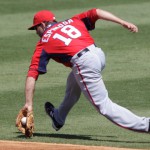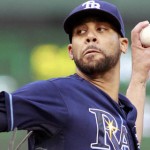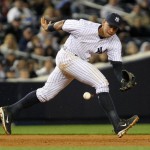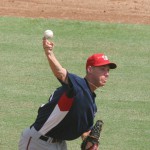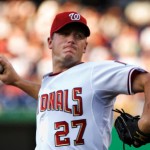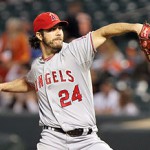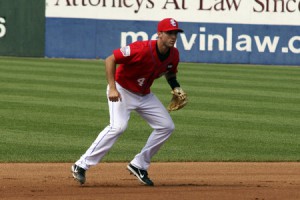Ah, what a great way to bring in the new year, with another edition of Bill Ladson‘s inbox (dated 1/2/14).
As always, these are real questions from presumably real people, and I answer here before reading Ladson’s answer.
Q: Do you think that Denard Span will be the leadoff hitter, with maybe Ian Desmond batting second? If so, shouldn’t the order be reversed since Desmond is a much better offensive player?
A: The answer to this question goes to the evolving lineup construction question and a rising opinion in the Sabre ranks that states that a team’s “best” hitter should be batting 2nd. Joe Sheehan discussed why the Reds specifically should have been batting Joey Votto 2nd instead of 3rd in this July 2013 article on SI.com, but his arguments were less about Votto and more about the idiocy of Dusty Baker‘s insistence on batting a sub-par hitter ahead of Votto all year. The real proof is from Tom Tango in his publication The Book, which is summarized in this 2009 BeyondtheBoxScore post by Sky Kalkman. Basically the argument is that a #2 hitter is slightly more important situationally than a #3 hitter, based on the fact that the #2 hitter bats more frequently than the #3 hitter, often bats with the bases empty and thus needs to be both a high OBP and a high average guy to be able to either set things up for the #3/#4 guys behind him or to do something with the #1 guy who just got on base ahead of him.
Now that being said, nothing trumps a good OBP in the lead-off spot. Last year our best OBP guy was Jayson Werth, but he also had the best average AND hit 25 homers. Hmm; maybe Werth is your #2 hitter right now. Desmond’s OBP was slightly better than Span’s on the season (.331 to .327), but Desmond hits for a ton of power. Span is the prototypical lead-off hitter; he’s a lefty, he’s fast, and he normally gets on at a .350 OBP clip (career .351). So right now if it were me I’d be batting Span 1, Werth 2 and Desmond somewhere around #5.
Todd Boss the Nats manager puts out this line-up opening day: Span-Werth-Zimmerman-Harper-Desmond-LaRoche-Ramos-Rendon-Strasburg. Good lefty/righty balance, has your best all-around hitter in the #2 hole and your best power hitter in the #4 hole, with Desmond getting more ABs than LaRoche right now and the rest of the lineup cascading down normally.
Ladson posts his lineup, which uses more conventional thinking and has LaRoche batting before Desmond. I think he’s wrong there; LaRoche was clearly not a better hitter than Desmond and has no business batting ahead of him in this lineup right now.
Q: The Nationals recently signed D.C. native Emmanuel Burriss to a Minor League contract. Is he a viable candidate for a backup role with the club in 2014?
A: I think the Emmanuel Burriss signing was about AAA depth, not a real attempt to find a utility infielder who can contribute at the MLB club. Look at his 2013 slash line: .213/.270/.221. Wow, that’s really bad. Of course, that’s still better than what Danny Espinosa did last year … Presumably Burriss is competing with Espinosa and Zach Walters for that backup middle infielder spot. Burriss’s problem is that he’s a minor league/non 40-man signing while both Espinosa and Walters are already on the 40-man … so for the time being I see him with fellow locally-tied minor league signee Wil Rhymes (he went to college at W&M) as Syracuse’s middle infield. Ladson thinks he’s a candidate but not a starter … and then predicts that the team will be trading Espinosa.
Q: If Espinosa makes the team as a bench player, my concern is his clubhouse attitude. Do you think management shares this concern as well?
A: Great question; who here knows Espinosa personally to see how he may react? Who here works in the Nationals organization and can effectively judge Espinosa’s character, given everything that’s happened to him in the past year (injuries, performance, loss of starting job and demotion)? Not me, and presumably nobody reading this, so its all just fan speculation.
So, given that I don’t know anything about the guy, here’s what I think: He has to realize that a) he’s no longer a starter here and b) he’s not even guaranteed a bench spot thanks to his 27 OPS+ hitting last year. But, he also has to realize that his best shot at this point of regaining a starter job in the majors is going to be to perform, and perform ably, wherever he gets his chance, and thus either improve his trade value to make him more valuable to other organizations or possibly to force his way over someone in the Nats organization. That chance may end up being full time in AAA but it’ll be better for him if he’s at least a backup in the majors. If he doesn’t realize these things, then his representation is doing him a massive disservice (and I don’t think Scott Boras is bad at his job). So my guess is that he’ll swallow his pride knowing he has to be in the majors to show that he can produce in the majors and will embrace his role.
There’s also the small issues of money and service time; he’s making peanuts in AAA versus what he makes riding the bench in the majors. And, if he makes the bench for at least 2 months or so in 2014 he accrues enough service time to hit arbitration following next season … which means either a pay raise or freedom to move to another organization where he may not be as blocked as he is in Washington. So no matter what, it is in his best interests professionally and financially to make the team, no matter what the role, out of spring training.
One last point: just ONE injury anywhere in the infield opens a massive swinging door for him to not only get playing time but likely to start. He has to be ready.
Ladson says Espinosa works hard and that Jayson Werth would get him in line if he had an attitude problem.
Q: What is the situation behind the plate? Ever since Ivan Rodriguez retired, it seems that’s been an injury-riddled spot. Why aren’t the Nationals making any moves for a backup catcher?
A: Catcher is an injury-riddled spot for nearly everyone in the league; the guys get beat up and miss time no matter if they’re the best or worst guy in the league. I’m guessing the team is actively in the market for backup catchers, but so are a bunch of other teams. I still count 10 catchers out there available in free agency and I’m guessing teams in need are all still jockeying for position with the better and lesser candidates. I’m sure we’ll sign at least one more guy to be in the mix with Jhonatan Solano, Sandy Leon and Chris Snyder. Plus there’s this: nearly every catcher who can still crouch will get a spring training gig because there’s just so many arms that need to throw simaltaneously for these teams. So we’re sure to see more guys sign up. Ladson says they’re trying to acquire more catcher depth but have been unsuccessful.
Q: How come Zach Walters is not being given a decent shot at making the team out of Spring Training? He has pop and is adequate defensively.
A: I don’t think people are saying that; I think the consensus seems to be that the backup infielder spot is Espinosa versus Walters right now. Who would you rather have? I think i’d lean towards one more chance for Espinosa (the guy did hit 20 homers in 2011 after all) and then either trade him or move him out. The concern with Walters (despite his 29 homers in AAA in 2013) is his strike-outs; they’re pretty high. You put up with 1 K/game if you get 30 homers … not if you get 10. He hit nearly 30 in AAA; can he do that in the majors? Ladson points out an important note; new manager Matt Williams knows Walters from when they were both in the Arizona system. Hmm. Will that have an effect?
Q: Would you try to get Eric O’Flaherty on the Nats if you were Mike Rizzo?
A: I’m not sure I would; he had TJ surgery in late May 2013 (5/21/13 specifically), meaning he’s looking at likely a May 2014 return date. So he’s likely missing the first 2 months of the season, and even then he’s on a shorter leash next season. Is this what the Nats need? My guess is that he re-signs an incentive deal with Atlanta out of some sort of professional courtesy for having gotten injured on their watch. Ladsons agrees with me and thinks he goes back to Atlanta.
Q: Shouldn’t the Nats bid on pitcher Masahiro Tanaka?
A: Bid yes. Go crazy and blow $20M/year on the guy? No way. Scouting reports thus far seem to indicate that Masahiro Tanaka is good but not Yu Darvish-good. And this team needs to start thinking about extending its own known quantity guys versus blowing that money on a lottery ticket like Tanaka. My guess is that a team with deeper pockets (Los Angeles, New York) or a team with more desparation (Seattle) agrees to pay Tanaka just ridiculous amounts of money. Ted Lerner seems to be indicating we’re nearing the team’s payroll budget and we’re going to start having to get creative fitting in some of these mid-to-upper level talents we have now accumulated. Ladson doesn’t really consider the merits or consideration of Tanaka, instead just saying the rotation is set. I’m not sure that was the question.
